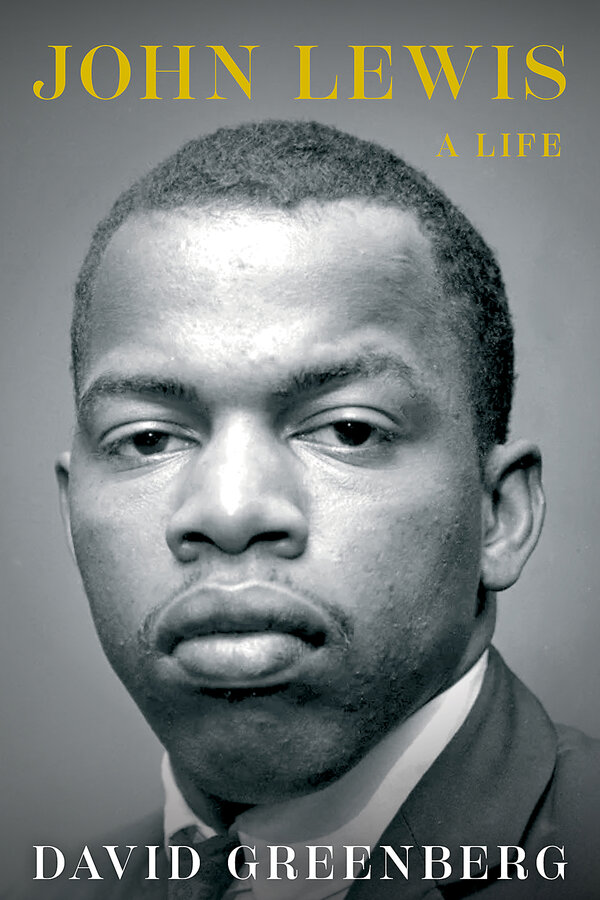John Lewis served as ‘the conscience of the Congress’
Loading...
John Lewis’ heroism is the stuff of legend. In 1965, leading 600 peaceful protesters across the Edmund Pettus Bridge in Selma, Alabama, at a march for voting rights, the civil rights activist was seriously injured when state troopers attacked the procession. A photograph of him being viciously beaten by an officer shocked the United States. A week after what became known as Bloody Sunday, President Lyndon B. Johnson introduced the landmark Voting Rights Act to Congress in a televised address.
David Greenberg’s rich, illuminating biography, “John Lewis: A Life,” situates its subject’s best-known act of bravery within a lifelong commitment to nonviolent protest. The author describes how Lewis, who went on to serve in Congress for more than 30 years, immersed himself in passive resistance while a student at the American Baptist Theological Seminary in Nashville, Tennessee.
His path was a difficult one. Lewis was born to sharecroppers in rural Pike County, Alabama, in 1940. His father saved up to buy his own farmland when Lewis was a child; the household, which included 10 children, had no electricity or running water. But the devout young Lewis, who famously preached to the chickens on his family’s land, was hungry to become educated and to involve himself in the civil rights struggle. Lewis, who also studied religion and philosophy at Fisk University, was the first person in his family to earn a college degree.
Why We Wrote This
The stories of courageous men and women fighting for civil rights in the 1960s inspire awe and gratitude. Activists like John Lewis risked their health, safety, and liberty to stand for justice.
In Nashville, Lewis was trained in passive resistance by the Rev. James Lawson, a significant mentor. Lewis helped organize sit-ins to desegregate the city’s lunch counters in 1960. He was among the original Freedom Riders, the interracial group of activists that rode buses throughout the Jim Crow South in 1961 to challenge segregated interstate travel.
Greenberg, a professor of history and journalism at Rutgers University, crafts a vivid portrayal of his subject, featuring his “steely determination ... mixed with an unmistakable gentleness.” Jesus, Gandhi, and Martin Luther King Jr. were among Lewis’ influences. His profound commitment to nonviolence never wavered. “You have to love that person who’s hitting you,” he said.
Indeed, he had been hit – and kicked, cursed at, and spat upon – long before Selma. During the Freedom Rides, he was badly injured by a group of young men when he walked into a whites-
only waiting room in a South Carolina bus station, and he was later beaten in Montgomery by a mob. Lewis was arrested dozens of times and spent weeks in jail. He spent one birthday and one Christmas behind bars; he missed his graduation from the seminary, opting to remain jailed rather than post bail.
A founding member of the Student Nonviolent Coordinating Committee, Lewis became the civil rights organization’s chair in 1963. He was one of six organizers of the 1963 March on Washington for Jobs and Freedom, along with King, with whom he had an affectionate relationship. Both men encountered resistance from a more militant faction of the movement, which began to question the efficacy of nonviolence. Additionally, within SNCC, Lewis was seen as too cozy with the establishment. “Every time LBJ called, he’d rush his clothes to the cleaners and be on the next plane to Washington,” one member griped. In 1966, Lewis was ousted as chair and replaced by the more radical Stokely Carmichael, who popularized the term Black Power. A believer in an interracial “beloved community,” Lewis was heartbroken when SNCC later voted to eject whites from the organization.
The biography is divided into two sections: “Protest” is devoted to Lewis’ participation in the Civil Rights Movement, while “Politics” covers his more than three decades representing Georgia in the U.S. House of Representatives. It’s perhaps unavoidable that the second half of the book is somewhat less gripping than the first.
Greenberg’s admiration for his subject runs deep, but he makes clear that Lewis was not a saint (despite being designated one of the “Saints Among Us” in a 1975 Time magazine article). His 1986 campaign for Congress pitted him against his dear friend Julian Bond, a fellow activist then serving in the Georgia state senate. During a debate, Lewis alluded to Bond’s rumored cocaine use. Lewis won the seat, but his friendship with Bond never recovered.
Lewis’ long congressional career was not notable for legislative achievements. Instead, his “sharpest weapon,” the author observes, “was his moral authority.” He became known as “the conscience of the Congress.” Speaker of the House Newt Gingrich grumbled that “He needs to realize that he’s now a congressman, not a protester,” but Lewis relished being both. In 1988, he was arrested for demonstrating against apartheid outside the South African embassy; in 2016, he staged a sit-in on the House floor demanding action on gun control legislation.
Lewis died in July 2020, not long after protests erupted across the nation in the wake of the killing of George Floyd. Weeks before his death, he addressed the demonstrators in a statement that captured his life’s work: “History has proven time and again that nonviolent, peaceful protest is the way to achieve the justice and equality that we all deserve.” ρ






